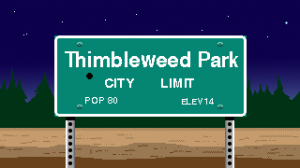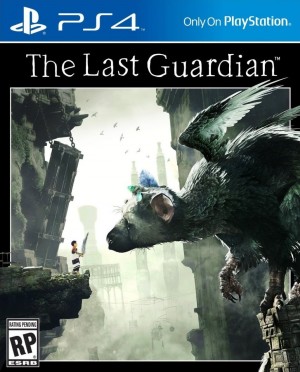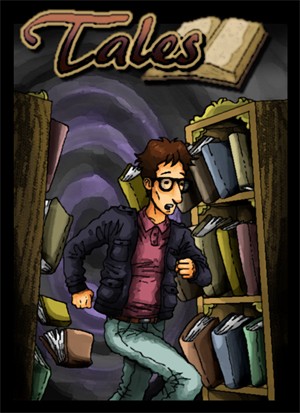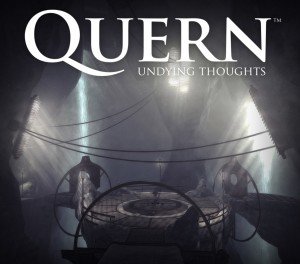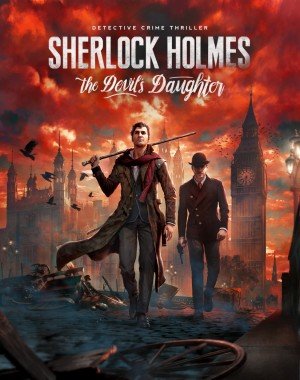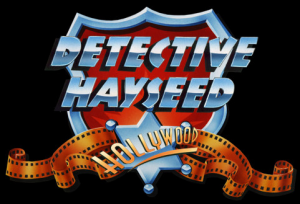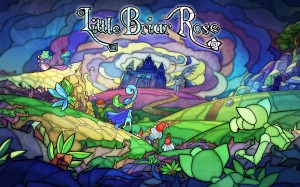Review for Thimbleweed Park
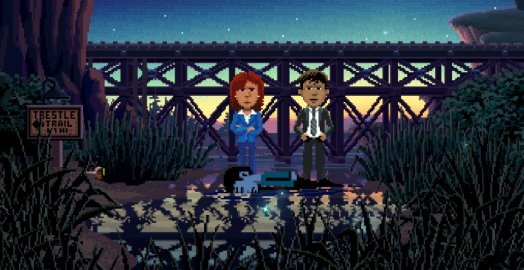
Game information
Adventure Gamers Awards
We can't talk about Thimbleweed Park without taking a step back. It's been exactly 30 years since the release of Maniac Mansion, an adventure game by Ron Gilbert and Gary Winnick. What stood out with that game is that, unlike its contemporaries in the genre that relied on a command line interface, Maniac Mansion revolutionized a verb-based, point-and-click interface. This approach was a massive innovation and influenced numerous graphic adventure titles from that point on, becoming a standard feature in the years that followed.
Fast forward to today, and it's fascinating to see how far adventure games have come, from games like Myst to Portal to The Walking Dead. Yet I often still find myself longing for adventure games as they were – or at least, how I remember them – not what they have become. Some of the games nowadays are tremendously enjoyable, but so many are stripped-down and streamlined for much shorter, less engaging experiences. A modern-day adventure game that's true to Gilbert and Winnick’s original pioneering vision is something I've been fantasizing about.
In 2014, that fantasy became a possible reality when the two men reunited to conceive Thimbleweed Park, an adventure game that would be highly reminiscent of the older classics. Or as they describe it: "like opening a dusty old desk drawer and finding an undiscovered LucasArts adventure game you’ve never played before," and yet one that’s also modernized for today’s gamer. A successful Kickstarter campaign showed that there was still solid interest in the genre, and with an actual budget behind the game, Ron and Gary began their quest. Now, a little more than two years later, Thimbleweed Park has been released. And boy, was it ever worth the wait.
The game starts off in the outskirts of the eponymous small town of 81 – make that, 80 inhabitants because of a recent murder. It’s 1987, and Special Agents Angela Ray and Antonio Reyes arrive at the crime scene separately, only to encounter the very dark, satirical and mysterious world that is Thimbleweed Park. Set along a dusty stretch of highway, the town once housed a vibrant business district and a magnificent hotel, held shows on its circus grounds, and was known for having the state's largest pillow factory. Nowadays, it’s a shadow of its former self, the once-flourishing community now a largely desolate and eerie place worthy of The X-Files.
While investigating the murder as both the experienced Senior Agent Ray and the enthusiastic Junior Agent Reyes, we not only meet other fascinating characters like the street-roaming alcoholic and the oddly similar sheriff and coroner, we actually get to play as three of them. In doing so, we experience their unique personal stories and start unraveling what happened to make the town what it is today. This method of introducing new characters is extremely well done. Instead of simply talking to them, we get to know more about them first-hand through the aid of playable flashbacks. During each person’s sequence, I became increasingly submerged into the story, like a great book you're reading that you just can't seem to put down. I really wanted to – no, had to – try to piece together what Thimbleweed Park was all about, and just how these strange citizens fit in.
Speaking of The X-Files, the two detectives are somewhat like Mulder and Scully, but with Scully (Ray) being a grumpy, cynical and dismissive character towards the younger, naive and determined Mulder (Reyes). Okay, not too many differences there. But these two are not partners, or at least only reluctantly so. Actually they don't even know each other at first and seem to have their own ulterior motives for being there besides the murder itself. So why are they on the case?
Two other playable characters are members of the Edmund family, an influential clan within Thimbleweed Park who built the town before overseeing its demise. What is it about the Edmunds and their burned-down pillow factory and once-thriving hotel? What mysteries are they concealing? We get to probe their history, playing as both Franklin Edmund (how does he end up in his ghostly form?) as well as his daughter, the aspiring video game developer Delores.
Our fifth and final protagonist is one that will easily stand out in any crowd, even his own: the obsessively swearing and cynical clown Ransome. His career is based on insulting his audience members, show after show, until he offends the wrong person and is cursed for life. His clown makeup becomes permanent and he descends into an even deeper phase of grumpiness and abuse. His dialog is hilarious, with multiple *beeps* per sentence, leaving little to wonder what is in its place. As we explore the peak of his career as well as the aftermath, post-curse, we’ll find out if there's still a shred of human dignity left in this clown and whether he might ever make amends for his mistakes.
In giving us so many diverse characters to play, Gilbert and Winnick have outdone themselves, taking the original model of Maniac Mansion with multiple protagonists not just to the next level but to a whole other league. Their stories, dialogs, unique personalities and interactions will delight, surprise and engage you as they suck you into the madness that surrounds them. Although Ransome is a *beeping* riot, my personal favorite was Delores. You get to know someone who is torn between her own dreams and family expectations, a real 'geek' that has a passion for creating entertainment for others that I can't help but feel very connected to. The same goes for a lot of Thimbleweed Park, as once you begin your journey into this surreal world, it will be difficult to disengage. Upon starting my initial playthrough, I couldn't help but continue non-stop, only briefly sleeping before jumping right back into this increasingly curious world.
Before you begin to play, you're able to choose if you want the 'easy' difficulty or the more challenging mode with more complex puzzles. I dove into the hard mode, but the fact that players new to the genre can choose an easier option is a welcome feature, though even that version is far more substantial than many new adventures. Once you launch the game, you'll be met with a quick overlay tutorial explaining the basics of interacting with the different protagonists and the world around you, before quickly being swept into the game proper.
Thimbleweed Park is played from a third-person perspective, with the bottom portion of the screen taken up by the inventory and list of action verbs. The key innovation of Maniac Mansion three decades ago, this verb list features actions such as 'pick up', 'open/close', 'talk to' and so on. What's been improved over the original implementation is that the background is still visible behind the text. You don’t have to click a verb for every interaction, as the game defaults to the most logical first option for each hotspot (usually ‘look at’), accomplished with a simple right-click. More involved interactions, however, do require manually selecting a verb to use first. This is part of the charm and is the main mechanism for resolving puzzles.
Navigating the town can be done without constantly clicking to advance, with your character able to walk twice as fast if you hold the right mouse button. In a sprawling world like Thimbleweed Park, this is a feature you'll use frequently. Other small improvements can also be found, with your pointer changing to an arrow to denote that the screen will scroll in that direction (or can be exited entirely). The town map you'll acquire at one point is a nice addition to the inventory as well, letting you travel between locations promptly.
Switching between different protagonists is achieved simply by clicking on the appropriate face icon in the top right. At certain times you are confined to the current protagonist, but after making key progressions with that character the option will open up again. Do keep a close eye on the active icons, as one time I didn't notice that I could play as Delores again after meeting her in present day. Up until that point, I was used to the characters other than Ray and Reyes only being available during flashbacks.
Even with most of the local businesses shuttered, there are many locations to discover in Thimbleweed Park, each with its own set of puzzles and mysteries, including the radio station, abandoned(?) sewers, the Edmund Hotel and family mansion, the forest and even the circus grounds. The challenge progresses quite gradually, scaling each time a new protagonist is added to the mix. These characters aren’t isolated, as you'll have to alternate between protagonists, exchange inventory items and have them work together to overcome obstacles. Protagonists have their own distinctive qualities and will be treated differently by the inhabitants of Thimbleweed Park. Fortunately, every character has a 'to do' list in their inventory, which notes what you need to achieve (some of which are shared between characters). This is an incredibly useful addition that keeps you on the quest at hand, though you can often pursue multiple goals at once.
While difficulty is always a delicate balance, even with two different levels to choose from, Thimbleweed Park manages to consistently find the happy medium with a healthy dose of clever puzzles and highly amusing, accessible objectives. With so many places to go, people to see, and things to do (and several characters to do them all with), you will be challenged at times but always with much enjoyment along the way. With thorough exploration, careful observation and a little lateral thinking, you should rarely find yourself too stuck. I had to use a walkthrough at one key point relating to a blood sample, and while the solution does make sense, I would have never figured it out. Overall, however, the puzzles are a fun addition that form the breadcrumbs of the story that make you want to devour them all.
Packed with humor, the script is a brilliant collaboration between Gilbert and his co-writers David Fox and Lauren Davidson. I often laughed out loud at certain scenes and characters, of which my personal highlight was undoubtedly Ransome the clown. His sharp wit and censored dialog is brilliant and unexpected at times, contributing greatly to the already humorous nature of the game. Even beyond the dialog, you'll find numerous things to chuckle at, from every machine being named a (Something)Tron™ to plumbers in pigeon suits and inventory items that will be instantly familiar to longtime adventure fans. There are many, many, in-jokes to Maniac Mansion, Lucasfilm ($1138?) and even a wink at Gilbert’s own life and career in the story of Delores trying to achieve her goal of joining MMucasFlem. Even the fact that the game itself takes place in 1987 has a nice nostalgic ring to it. Prior knowledge is by no means a requirement to enjoy the game, however. Thimbleweed Park is more a spiritual successor to Maniac Mansion than anything, meant to stand firmly on its own.
In an era where the games we play are increasingly in 3D, with perfect textures and immersive experiences through VR glasses, Thimbleweed Park stays true to its roots: Pixels. Lots of juicy pixels. I'm a massive fan of the retro-inspired games that use art similar to the genre’s golden era, and Thimbleweed Park doesn't disappoint. Featuring an art style that reminds me mostly of Zak McKracken with a touch of Monkey Island on top, this game is worthy of being added to that list. Don't let the old-school influence fool you, though, as the game is filled with techniques that would never have been possible back in the day. This is no 8-bit, 320x200 visual design, but a high-resolution, widescreen presentation filled with an abundance of gradient colors. It has great parallax scrolling as well, and multiple layers of depth, perfectly done in HD.
The background art by Mark Ferrari (whose Lucasfilm credits include Zak McKracken, Loom and The Secret of Monkey Island) and Octavi Navarro is utterly breathtaking, even more so considering that it was crafted pixel-by-pixel to create the beautiful scenes on display. The panoramic view of the town from on top of a hill is simply amazing. I found the opening scene gorgeous as well, with a train crossing in the background and the bridge tracks reflected in the water in the foreground, but there are many others just as stunning and highly detailed. The use of shadow and light is tremendous, from flickering bulbs to darkened alleys to illuminated signs, and walking around feels immersive due to the exceptional use of depth perception. These are not just beautifully drawn backgrounds with characters projected onto them; they feel completely unified in one cohesive world.
Animations are simple yet well done; getting all of our protagonists to puke at some point is a pure devilish joy to see (and do). Even some of the inventory items are animated, with small details added like a blinking indicator of low power. There are several cinematics throughout the game, all of which feel complementary, never forced. During cutscenes and conversations with other characters, the verbs/inventory area slowly fades out and back in once finished, which is a nice touch.
Adding to the outstanding art is a fantastic score by Steve Kirk that will ensure you remain fully immersed. The game's opening music with piano chords and guitars directly sets the tone for the unusual experience to come. The eclectic pieces throughout fit the different areas and plots like a glove, as well as the eras in which the events take place. Jaunty circus-style melodies with trumpets give way to snares being hit mysteriously in the background to provide a haunting atmosphere.
Most areas have ambient sound effects, from winds howling in the circus grounds, to crickets chirping when examining the map, to dogs barking in the streets of Thimbleweed Park, all done in a way that's non-repetitive and enhances the overall experience. It sounds so authentic that at one point I was convinced that dogs were barking outside of my apartment. It wasn't until I noticed it was 3 AM and quiet as a mouse outside that it dawned on me that some of the noises I heard the last few hours were actually part of the game. It's truly that immersive.
Part of what makes Ransome so hilarious is the excellent voice-over that accompanies his dialog. His voice is raw and rough, which makes a perfect match with the raunchy things he says. With just one exception (the starting character with a German accent who sounds a little weird, but who fortunately never appears again), this praise applies to everyone in Thimbleweed Park. Each person’s voice fits their personality incredibly well, including the supporting characters with smaller roles. They don’t just speak lines to advance the plot; they all have their own distinctive quirks and mannerisms and sayings that truly make them unique.
This blend of riveting story, bizarre characters, engaging gameplay and top-notch production values makes for an incredibly deep and compelling adventure game that pulls you into its world and doesn't let you go until you unravel all of its crazy secrets. No matter what you think this mystery will be about, nothing prepares you for what is in store. I spent at least 20 hours playing the game, and that was pushing myself through to the finish, with a few puzzles I solved more by accident than skill, which could have otherwise taken much longer. By far one of the best adventure games I've played since the nineties, it flies directly to my personal top three. Although nothing will replace my nostalgic fondness for Monkey Island, Thimbleweed Park has created an entirely new set of thoroughly memorable experiences that I'll cherish for a long time.
Author's note: I've recorded my entire playthrough of Thimbleweed Park, which are available in episodes of around 30-45 minutes. If you're interested in seeing it (edited for a more viewer-friendly experience), check out the first episode.
WHERE CAN I DOWNLOAD Thimbleweed Park
Thimbleweed Park is available at:
We get a small commission from any game you buy through these links (except Steam).Our Verdict:
An incredible game that takes all the best parts of how classic adventures used to be made and then adds so much more to ensure it stands up to today’s standards. Thimbleweed Park is a gem that will be remembered for at least another 30 years.


